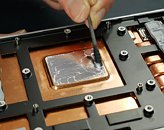- Joined
- Oct 9, 2007
- Messages
- 47,364 (7.52/day)
- Location
- Hyderabad, India
| System Name | RBMK-1000 |
|---|---|
| Processor | AMD Ryzen 7 5700G |
| Motherboard | ASUS ROG Strix B450-E Gaming |
| Cooling | DeepCool Gammax L240 V2 |
| Memory | 2x 8GB G.Skill Sniper X |
| Video Card(s) | Palit GeForce RTX 2080 SUPER GameRock |
| Storage | Western Digital Black NVMe 512GB |
| Display(s) | BenQ 1440p 60 Hz 27-inch |
| Case | Corsair Carbide 100R |
| Audio Device(s) | ASUS SupremeFX S1220A |
| Power Supply | Cooler Master MWE Gold 650W |
| Mouse | ASUS ROG Strix Impact |
| Keyboard | Gamdias Hermes E2 |
| Software | Windows 11 Pro |
In our own testing of the Radeon VII, we found that adding washers to the GPU retention bracket to increase mounting pressure reduces temperatures by up to 10°C. You can learn more about what we did in the Overclocking section of our Radeon VII review. Replacing the thermal pad between the Radeon VII GPU and its cooler with liquid metal TIM was found to lower the GPU's maximum junction temperature by 5 °C, and a 24 MHz gain in minimum sustained engine clock speed was observed, by German professional overclocker Roman "der8auer" Hartung. AMD uses a strip of highly conductive Hitachi Chemical TC-HM03 thermal pad as the interface material between its reference Radeon VII cooling solution and the "Vega 20" MCM. Based on vertically-oriented graphite strands, the TC-HM03 is rated to offer 25-45 W/m·K of thermal conductivity, which beats most aftermarket fluid TIMs on paper, including those based on diamond. The conductivity and longer lifespan compared to fluid TIMs is probably why AMD chose it.
Liquid metal is the best possible DIY thermal interface material currently available in the retail market, however it requires careful application because it is electrically conductive and can short open vias or SMDs. der8auer used nail polish to insulate the SMD electrical components surrounding the GPU die on the fiberglass substrate. After drying it, a generous amount of liquid-metal was spread over the uniform MCM cluster. To prevent any air-gaps between the cooler and the TIM layer that's bound to be thinner than the thermal pad, a layer of liquid metal was also coated on the base of the cooler. The retention module was fastened a little on the tighter side. The maximum junction temperature of the GPU lowered from 106 °C to 101 °C, and the minimum GPU clock sustained increased from 1709 MHz to 1733 MHz. The boost frequency, however, remained around 1780 MHz. You can watch the full video presentation by der8auer here.



View at TechPowerUp Main Site
Liquid metal is the best possible DIY thermal interface material currently available in the retail market, however it requires careful application because it is electrically conductive and can short open vias or SMDs. der8auer used nail polish to insulate the SMD electrical components surrounding the GPU die on the fiberglass substrate. After drying it, a generous amount of liquid-metal was spread over the uniform MCM cluster. To prevent any air-gaps between the cooler and the TIM layer that's bound to be thinner than the thermal pad, a layer of liquid metal was also coated on the base of the cooler. The retention module was fastened a little on the tighter side. The maximum junction temperature of the GPU lowered from 106 °C to 101 °C, and the minimum GPU clock sustained increased from 1709 MHz to 1733 MHz. The boost frequency, however, remained around 1780 MHz. You can watch the full video presentation by der8auer here.



View at TechPowerUp Main Site





